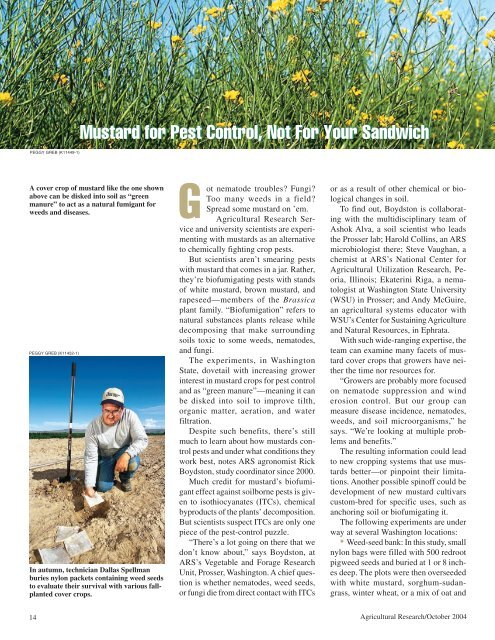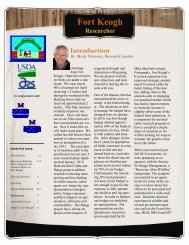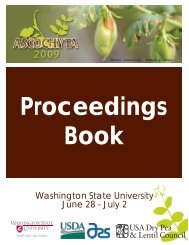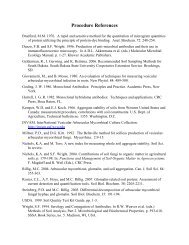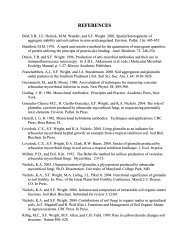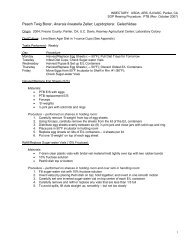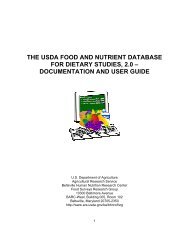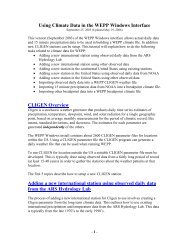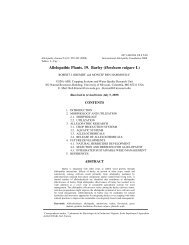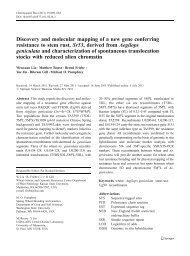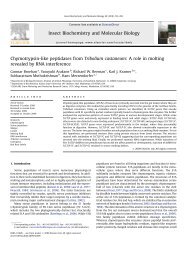Mustard for Pest Control, Not For Your Sandwich - Agricultural ...
Mustard for Pest Control, Not For Your Sandwich - Agricultural ...
Mustard for Pest Control, Not For Your Sandwich - Agricultural ...
You also want an ePaper? Increase the reach of your titles
YUMPU automatically turns print PDFs into web optimized ePapers that Google loves.
PEGGY GREB (K11449-1)<br />
PEGGY GREB (K11452-1)<br />
14<br />
<strong>Mustard</strong> <strong>for</strong> <strong>Pest</strong> <strong>Control</strong>, <strong>Not</strong> <strong>For</strong> <strong>Your</strong> <strong>Sandwich</strong><br />
G<br />
A cover crop of mustard like the one shown<br />
above can be disked into soil as “green<br />
manure” to act as a natural fumigant <strong>for</strong><br />
weeds and diseases.<br />
In autumn, technician Dallas Spellman<br />
buries nylon packets containing weed seeds<br />
to evaluate their survival with various fallplanted<br />
cover crops.<br />
ot nematode troubles? Fungi?<br />
Too many weeds in a field?<br />
Spread some mustard on ’em.<br />
<strong>Agricultural</strong> Research Service<br />
and university scientists are experimenting<br />
with mustards as an alternative<br />
to chemically fighting crop pests.<br />
But scientists aren’t smearing pests<br />
with mustard that comes in a jar. Rather,<br />
they’re biofumigating pests with stands<br />
of white mustard, brown mustard, and<br />
rapeseed—members of the Brassica<br />
plant family. “Biofumigation” refers to<br />
natural substances plants release while<br />
decomposing that make surrounding<br />
soils toxic to some weeds, nematodes,<br />
and fungi.<br />
The experiments, in Washington<br />
State, dovetail with increasing grower<br />
interest in mustard crops <strong>for</strong> pest control<br />
and as “green manure”—meaning it can<br />
be disked into soil to improve tilth,<br />
organic matter, aeration, and water<br />
filtration.<br />
Despite such benefits, there’s still<br />
much to learn about how mustards control<br />
pests and under what conditions they<br />
work best, notes ARS agronomist Rick<br />
Boydston, study coordinator since 2000.<br />
Much credit <strong>for</strong> mustard’s biofumigant<br />
effect against soilborne pests is given<br />
to isothiocyanates (ITCs), chemical<br />
byproducts of the plants’ decomposition.<br />
But scientists suspect ITCs are only one<br />
piece of the pest-control puzzle.<br />
“There’s a lot going on there that we<br />
don’t know about,” says Boydston, at<br />
ARS’s Vegetable and <strong>For</strong>age Research<br />
Unit, Prosser, Washington. A chief question<br />
is whether nematodes, weed seeds,<br />
or fungi die from direct contact with ITCs<br />
or as a result of other chemical or biological<br />
changes in soil.<br />
To find out, Boydston is collaborating<br />
with the multidisciplinary team of<br />
Ashok Alva, a soil scientist who leads<br />
the Prosser lab; Harold Collins, an ARS<br />
microbiologist there; Steve Vaughan, a<br />
chemist at ARS’s National Center <strong>for</strong><br />
<strong>Agricultural</strong> Utilization Research, Peoria,<br />
Illinois; Ekaterini Riga, a nematologist<br />
at Washington State University<br />
(WSU) in Prosser; and Andy McGuire,<br />
an agricultural systems educator with<br />
WSU’s Center <strong>for</strong> Sustaining Agriculture<br />
and Natural Resources, in Ephrata.<br />
With such wide-ranging expertise, the<br />
team can examine many facets of mustard<br />
cover crops that growers have neither<br />
the time nor resources <strong>for</strong>.<br />
“Growers are probably more focused<br />
on nematode suppression and wind<br />
erosion control. But our group can<br />
measure disease incidence, nematodes,<br />
weeds, and soil microorganisms,” he<br />
says. “We’re looking at multiple problems<br />
and benefits.”<br />
The resulting in<strong>for</strong>mation could lead<br />
to new cropping systems that use mustards<br />
better—or pinpoint their limitations.<br />
Another possible spinoff could be<br />
development of new mustard cultivars<br />
custom-bred <strong>for</strong> specific uses, such as<br />
anchoring soil or biofumigating it.<br />
The following experiments are under<br />
way at several Washington locations:<br />
• Weed-seed bank: In this study, small<br />
nylon bags were filled with 500 redroot<br />
pigweed seeds and buried at 1 or 8 inches<br />
deep. The plots were then overseeded<br />
with white mustard, sorghum-sudangrass,<br />
winter wheat, or a mix of oat and<br />
<strong>Agricultural</strong> Research/October 2004
hairy vetch. Other plots, left fallow, were<br />
either fumigated with metam sodium and<br />
1,3-dichloropropene or were not treated.<br />
In spring, sacks were dug up and the<br />
seeds removed and replanted to see<br />
whether they’d germinate. “If the seed<br />
doesn’t sprout, this suggests presence of<br />
toxins, such as ITCs, from the cover crop<br />
we used,” explains Boydston. Citing<br />
2003 results, he adds, “We’re not seeing<br />
a big effect on buried seed, though we<br />
do see a delay in germination.” By comparison,<br />
99 percent of seed from fumigated<br />
plots didn’t sprout.<br />
• <strong>Mustard</strong> mulching: This Prosser<br />
greenhouse study pits three biofumigant<br />
crops (white mustard, brown mustard,<br />
and rapeseed) against small-seeded<br />
weeds—redroot pigweed and barnyard<br />
grass. When mixed into soil, the three<br />
mulches cut weed germination by 20 percent<br />
to 95 percent. Reductions of 5 percent<br />
to 95 percent in growth of seedlings<br />
from surviving seeds were also<br />
observed.<br />
• Potted ornamentals: This greenhouse<br />
study evaluated the biofumigant<br />
effects of crushed seed meal from brown<br />
mustard and field pennycress. The targeted<br />
pests were chickweed, prickly lettuce,<br />
and root-knot nematode.<br />
First, scientists mixed the seed meal<br />
at 0.2 percent to 0.4 percent by weight<br />
into potting soil and then planted irises.<br />
They then added 100 chickweed seeds,<br />
100 prickly lettuce seeds, and 400 nematodes.<br />
As a chemical control, other pots<br />
were sprayed with the nematicide ethoprop.<br />
At 2, 4, and 6 weeks, they checked<br />
the pots <strong>for</strong> diminished seed germination<br />
and sprouting. Nematodes were extracted<br />
and counted at the experiment’s end.<br />
In pennycress-treated pots, about 80<br />
percent fewer chickweed seeds and 55<br />
percent fewer prickly lettuce seeds<br />
sprouted. Brown mustard seed meal reduced<br />
chickweed emergence by 65 percent<br />
and prickly lettuce by half. The irises<br />
were unaffected. Early results revealed<br />
a 70 percent to 80 percent nematode decline<br />
in pots containing the seed meals.<br />
The scientists are now testing higher<br />
seed-meal concentrations and expect to<br />
see even fewer nematodes.<br />
• Crop rotation: Since 2000, the researchers<br />
have preceded potato or sweet<br />
corn crops with fall-planted cover crops<br />
<strong>Agricultural</strong> Research/October 2004<br />
of mustard, winter wheat, sorghumsudangrass,<br />
or oat plus hairy vetch.<br />
Another plot, left fallow, is fumigated <strong>for</strong><br />
comparison. “We have a 4-year rotation<br />
in place and are using these covers in 3<br />
of the 4 years,” says Boydston. “We hope<br />
to detect any cumulative effects of the<br />
cover crop’s continued use.” Throughout,<br />
the scientists are monitoring the covers’<br />
effects on weed emergence, seedling<br />
growth, species distribution, and density.<br />
• Biomass: Using mustards costs<br />
about $90 per acre, notes McGuire.<br />
Growers can generally recoup by rotating<br />
mustard with a high-return crop like<br />
potato. To help them get the most bang<br />
<strong>for</strong> their buck, the researchers are studying<br />
the best mustard-seeding time <strong>for</strong><br />
producing the most biomass, which is<br />
thought to be important <strong>for</strong> many of the<br />
crop’s benefits.<br />
They also want to determine the best<br />
time to disk mustard into the soil to unleash<br />
its biofumigants. Current thinking<br />
is that disking live, green mustard will<br />
trigger the greatest release of glucosinolates,<br />
which break down into ITCs. But<br />
other compounds or soil factors may contribute<br />
as much as or more than ITCs to<br />
suppressing weeds and diseases. To find<br />
out, researchers are comparing weed<br />
PEGGY GREB (K11451-1)<br />
Microbiologist Harold Collins evaluates<br />
soil bacterial diversity under various<br />
cover crop treatments.<br />
densities after mustard is disked into the<br />
soil in fall while it is still alive and in<br />
spring after it has died.<br />
In still other studies, Collins is looking<br />
at how microbial soil communities<br />
may change in response to mustards and<br />
their decomposition. He and Alva are<br />
also using isotopes of nitrogen to trace<br />
how much of this nutrient mustard returns<br />
to soil <strong>for</strong> other crops to use.<br />
McGuire evaluates various mustard<br />
cultivars, including some from Italy and<br />
Germany, <strong>for</strong> their ease of growth, flowering<br />
times, biomass, and glucosinolates.<br />
Meanwhile, WSU colleague James<br />
Dobrowolski is testing wind-erosion<br />
resistance of mustard-amended soil by<br />
blasting it with gusts from a wind machine.—By<br />
Jan Suszkiw, ARS.<br />
This research is part of Integrated<br />
Farming Systems, an ARS National Program<br />
(#207) described on the World<br />
Wide Web at www.nps.ars.usda.gov.<br />
Ashok Alva, Rick A. Boydston, and<br />
Harold Collins are in the USDA-ARS<br />
Vegetable and <strong>For</strong>age Crops Research<br />
Unit, 24106 N. Bunn Rd., Prosser, WA<br />
99350; phone (509) 786-9228, fax (509)<br />
786-9277, e-mail aalva@pars.ars.usda.<br />
gov, boydston@pars.ars.usda.gov,<br />
hcollins@pars.ars.usda.gov. ★<br />
PEGGY GREB (K11450-1)<br />
Agronomist Rick Boydston and Harold<br />
Collins record weed density in potatoes<br />
after cover crop treatments.<br />
15


